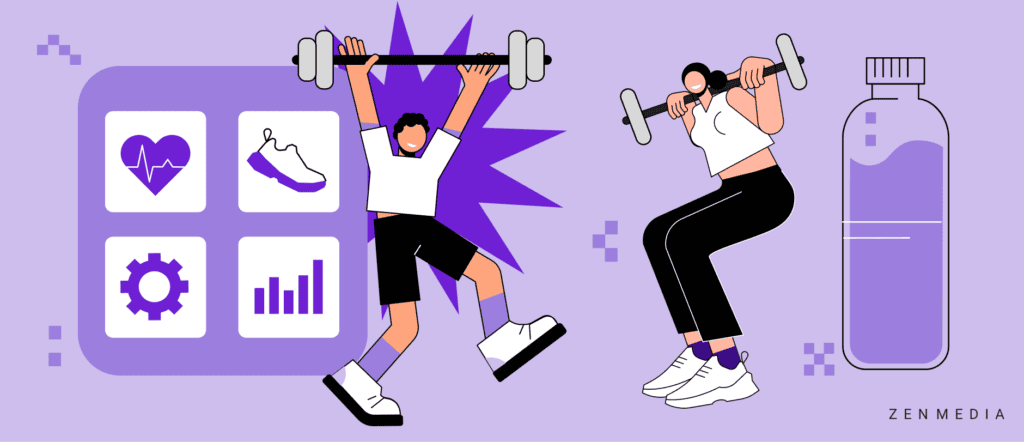You might wonder what content marketing has to do with powerlifting. As a competitive powerlifter and content marketer, I’ve discovered that the foundational elements of both worlds intersect more than you’d think.
The drive for excellence—in both content marketing and powerlifting—converges around three pillars: stance, elevation, and amplification. Just as a powerlifter relies on the fundamentals of the squat, deadlift, and bench press, a content marketer should focus on establishing a solid stance, lifting content off the ground, and supporting and amplifying content.
Still not sold on the analogy? Allow me to elaborate:
The Squat = Setting Your Brand’s Stance
In powerlifting, a proper squat requires a solid foundation. Every lift starts with the right stance, and every content strategy begins with a clear, firm position. The most important part? That position evolves with time.
My own experiences in the weight room have shown that my stance isn’t static; it adjusts and evolves. When lifting lighter, my feet might spread wider; with heavier weights, they draw inward. This subtle change isn’t happenstance; it’s a response, a recalibration to external demands and internal shifts.
What does this mean for marketing?
Your brand’s content must have a stance, and it should be re-evaluated every so often. It’s also a cue to listen to feedback. In powerlifting, the feedback might come from my coach, my lifting friends, or even the feeling in my joints and muscles. For brands, feedback pours in from customers, market trends, and performance metrics. Tuning into these feedback channels helps refine the stance, ensuring it’s optimized for current conditions.
This is especially important after an injury (or a PR crisis).
Recalibrating Your Stance
I recently recovered from a hamstring injury that forced me to modify my training for about five weeks. So my coach and I are retesting squats. I had to listen carefully—to my body and my coach—to know when to stop. This feedback often contains subtle (or not subtle, if you’re my coach) hints at what I can do to improve my stance. For some powerlifters, a slight adjustment in foot placement can make the difference between a failed and successful lift.
In branding, nuanced changes—a tweak in the tone, a shift in messaging, or a slight pivot in positioning—can have significant impacts on audience engagement and perception. Before you make changes—and when you are making them—look at what your feedback says. It can and should be the data that informs how you refine your brand’s stance.
My squat stance differs from others’, and even from my past self. It’s tailored to my current physique, strengths, and the weight I’m about to lift. Similarly, brands need to recognize that their stance will be unique, influenced by their history, values, and the current market landscape. Emulating competitors or sticking rigidly to an outdated brand image can be as detrimental as adopting a squat stance that doesn’t suit one’s body.
The last relation between squats and your brand’s stance? Get deeper, bro. No really. In competitive powerlifting, adequate squat depth is defined as having the top of the hip crease below the knee crease (slightly below parallel).
Consumers crave authenticity. A shallow squat won’t impress judges, and surface-level content won’t resonate with a discerning audience.
The Deadlift: Lifting Your Content Off the Ground
Once you’ve gripped your audience’s attention with discoverable content, you need to hold it.
There’s a fine balance between grip, form, and sheer power to lift weight off the ground. After my last meet in June, I needed to work on my grip strength; it was preventing me from literally being able to grip the bar to pull the weight. I could manage the weight; I just couldn’t hold the bar.
If you can’t hold the bar—or your audience’s attention—you aren’t going to make the lift (or conversion). The foundation of lifting content off the ground lies in its discoverability. Optimizing your content for search engines ensures that it gets found.
Much like how a solid, unyielding grip is quintessential to a successful deadlift, a well-optimized piece ensures that your content holds its ground in search results. Without proper SEO, even the most stellar content can remain hidden.
Getting a Grip and Holding It
The first thing I set in my deadlift is my grip. Then, I set my shoulders in a neutral position, flattening my back. This nuanced set of steps is crucial to a successful deadlift. If I don’t have a good grip, I’ll lose the bar. If I don’t set my shoulders, I’ll round my back, potentially hurting myself and definitely limiting my capabilities.
This is where your headline and hook come into play. They are the ‘shoulder set’ of your content piece. Fail in this, and your content will lose effectiveness like my lift loses strength.
Enhancing Your Grip
When a powerlifter approaches a barbell, chalk often plays a critical role in improving their grip. Much like a gymnast’s use of chalk, lifters use it to soak up the moisture on their hands and prevent bar slippage.
Drawing a parallel in content marketing, visuals, and videos are that ‘chalk’. They amplify content’s reach and engagement. Visuals interrupt text monotony, capturing readers’ attention, while videos offer an immersive dive into a topic. Lacking these elements, even compelling content risks fading into digital obscurity, much like a lift without the right grip.
The Bench Press: Supporting and Amplifying Content
The bench press is more than just pushing weight off your chest—it’s about technique, support, and employing a range of muscle groups. There’s a tendency to think a bench press is a test of arm and chest strength. During a bench press, you hardly rely on arm and chest muscles. The shoulders, triceps, lats, and even the legs play vital roles in moving the weight smoothly and safely.
Similarly, in content creation, you shouldn’t rely on one format or platform. Repurpose and adapt your content across different media—be it blogs, infographics, or podcasts—to effectively push your message to a wider audience. Diversifying your content strategy ensures that you tap into various audience segments, maximizing reach and impact.
It may seem like bench pressing is about raw strength, but it’s really an intricate alignment of technique in the way a lifter sets their shoulders, hips, and feet, how they breathe, and even whether they lift the bar off the rack themselves or have their spotter give them a lift-off (put it in their hands).
In content, this finesse is reflected in how content is promoted and amplified, especially through social channels. A well-timed tweet or a targeted share can be the “technique” that propels content into the spotlight. (Or, puts it in your audience’s hands, literally and figuratively.)
The bench press gets even more complicated in a competition where lifters must hold the weight for a two-count pause (or until the judge tells them to press) at their chest. The bar must come to a complete stop before the two-second count begins. Oh, and if your feet leave the floor or your hips leave the bench, then it’s a no-lift. Sound like a lot of little things to manage?
Welcome to content amplification.
Amplify Your Content
Amplifying content isn’t a singular act. It’s a culmination of multiple strategies working in harmony—SEO optimization, audience engagement, branding consistency, and timely publishing.
Like a well-rounded powerlifting program, successful content marketing requires balancing and integrating all three of these components. When your content’s stance, elevation, and amplification work in tandem, you’re setting up a powerful content strategy—a strategy that not only informs but also engages, persuades, and retains your audience.





